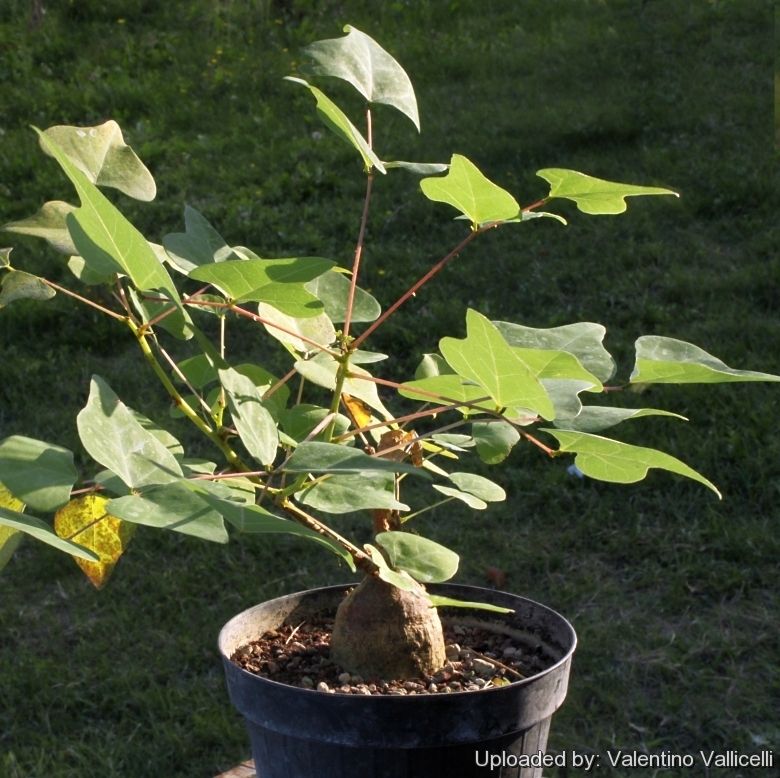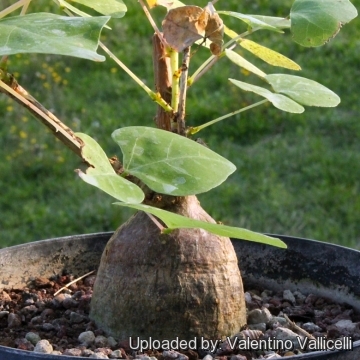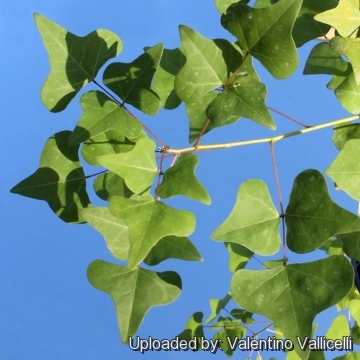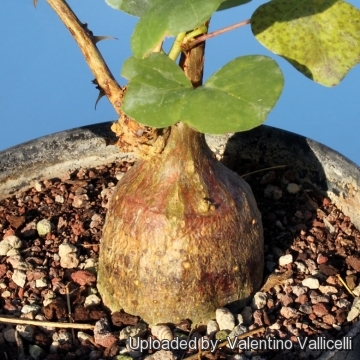Accepted Scientific Name: Erythrina herbacea L.
Sp. Pl. 2: 706. 1753 [1 May 1753] L.

Corallodendron herbaceum (Erythrina herbacea) Photo by: Valentino Vallicelli
Origin and Habitat: Widespread from south-eastern United States along the Gulf Coast (Texas, Oklahoma, Florida, and North Crolina) into eastern Mexico (Tamaulipas). It has also been reported from parts of Central America and, as an introduced species, from Pakistan.
Habitat: It grows in sandy low woods, open bushy forests, savannas, disturbed areas, swamp and pond margins not far from the sea coast.
Synonyms:
See all synonyms of Erythrina herbacea
back
Accepted name in llifle Database:Erythrina herbacea L.Sp. Pl. 2: 706. 1753 [1 May 1753]Synonymy: 8
back
Common Names include:
ENGLISH: Cardinal Spear, Coral bean, Crybaby Tree, Christ's Tears, Red Cardinal, Cherokee-bean, Cherokee bean, Eastern coralbean, Southern coralbean, Colorin
FRENCH (Français): érythrine de l'est
HUASTECO (Teenek): Jutucú
NAHUATL (Nāhuatl): Péjmoch
SPANISH (Español): Colorín, Patol, Pemoche (Mexico)
Description:
Erythrina herbacea is a multistemmed thorny herbaceous shrub or small tree 1,5 to 5 m tall and 90-150 cm wide in areas that do not kill it back by freezing. Although evergreen in the tropics, it gets killed to the ground each year in places where freezing weather occurs, which limits its height to less than 1,2 m. The species is deciduous but retains its foliage late into the season. In dry sites it may flower on bare stems and can develop a swollen caudiciform base. This shrub or small tree is sometimes called the crybaby tree or Christ's tears because nectar drips from the blossoms like tear-drops. Related to the coral bean is the coral tree (Erythrina crista-galli).
Root: Tuberous large contorted branched below.
Stem: The plant forms a perennial woody caudex from which long branches armed with short, recurved spines sprouts every year. The bark is smooth and light grey. Branches, greenish to purplish 60-90 or more cm high mostly herbaceous, but often perennial in tropical climates where the plant may give rise to small trees.
Leaves: Alternatively arranged, yellowish-green, 15-50 cm long and trifogliate (composed of three shallow-lobed). Leaflets, coriaceous smooth, sub-hastate or deltoid with long, narrow pinched tips, the terminal leaflet larger than the lateral and the latter often differing in size and shape, with prickles on the midribs and on the undersides. Petioles aculeate.
Inflorescence: One to several leafless scapes supported by tall stalks are terminated by a very long, plume-like, raceme of showy scarlet flowers and contrast sharply with the plant's green foliage.
Flowers: 4–6,5 cm long, slender bright red, though papilionaceous, appear tubular, deep carmine red. Pedicels for the most part ternate sometimes solitary and irregularly scattered always one flowered Calix sub-bilabiate, truncated, entire, without honey glands at the base suddenly attenuated and corrugated with longitudinal furrows at its juncture with the pedicel. Vexillum of the corolla very long and lanceolate. Wings and keel inconspicuous very short membranous and of a dingy purple hue.
Blooming season: Coral bean blooms in several waves between spring and autumn and continue for months.
Fruits: Legumes (beans) 5-10 cm long, dark scarlet to blackish, torulose, constricted between the seeds, when the beans burst open reveal bright red seeds with a black eye that are attractive but poisonous.
Bibliography: Major references and further lectures
1) William Paul Crillon Barton “A Flora of North America: Illustrated by Coloured Figures, Drawn from Nature, Volume 1” M. Carey & Sons, 1821
2) M. Carey & sons, 1821Marie Harrison “Flowering Shrubs and Small Trees for the South” Pineapple Press Inc, 15/Mar/2009
3) Nelson, Gil “The Trees of Florida: a Reference and Field Guide.” Pineapple Press Inc. 1994.
4) Delena Tull “Edible and useful plants of Texas and the southwest: a practical guide” University of Texas Press, 1999
5) George E. Burrows, Ronald J. Tyrl “Toxic Plants of North America” John Wiley & Sons, 15/Oct/2012
6) Duncan, Wilbur H.; Marion B. Duncan “Wildflowers of the Eastern United States.” University of Georgia Press. 2005
7) Neyland, Roy “Wildflowers of the Coastal Plain: A Field Guide, Includes the Lower Mississippi River Valley, Gulf, and Atlantic Coastal States.” LSU Press. 2009.
8) Austin, Daniel F. “Florida Ethnobotany.” CRC Press. 2004.
9) M.M. Grandtner “Elsevier's Dictionary of Trees: Volume 1: North America, Volume 1” Elsevier, 08/apr/2005
10) “Bird Gardens: Welcoming Wild Birds to Your Yard.” Brooklyn Botanic Garden. 1998
11) Moerman, Daniel E. “Native American Medicinal Plants: An Ethnobotanical Dictionary.” Timber Press. 2009
12) Alden, Peter; Rick Cech, Richard Keen, Amy Leventer, Gil Nelson, and Wendy B. Zomlefer “National Audubon Society Field Guide to Florida.” New York: Alfred A. Knopf. 1998
 Corallodendron herbaceum (Erythrina herbacea) Photo by: Valentino Vallicelli
Corallodendron herbaceum (Erythrina herbacea) Photo by: Valentino Vallicelli Corallodendron herbaceum (Erythrina herbacea) Photo by: Valentino Vallicelli
Corallodendron herbaceum (Erythrina herbacea) Photo by: Valentino Vallicelli Corallodendron herbaceum (Erythrina herbacea) Photo by: Valentino Vallicelli
Corallodendron herbaceum (Erythrina herbacea) Photo by: Valentino Vallicelli Corallodendron herbaceum (Erythrina herbacea) Photo by: Valentino Vallicelli
Corallodendron herbaceum (Erythrina herbacea) Photo by: Valentino VallicelliCultivation and Propagation: Erythrina herbaceaSN|19016]]SN|19016]] can be readily grown in gardens within its natural range. This plant is also suited to greenhouse culture and does well out of doors in Mediterranean-temperate climate. It is a plant for people who don't want a source of early season colour, and seems to thrive on neglect.
Growth rate: The plants are slow growing, so don't expect great growth spurts from year to year.
Growing substrata: Grows in a rich, very well drained, sandy or loamy soil, both acid or slightly alkaline, and is drought tolerant once established.
Watering needs: It is somewhat drought tolerant, water deeply but infrequently in summer. It doesn't like a wet winter when the plant is dormant (after shedding its leaves), but will survive. It will start growing again in Spring. Watering can recommence once the plant has shown signs of producing a fresh shoot. They are pretty resistant to rotting if all other conditions are good.
Fertilization: Fertilize them only once during this period.
Exposition: Keep in full sun or light shade.
Hardiness: When it drops its leaves protect from frost and stop watering. It is hardy to -12 or less degrees Celsius if kept dry. However warmth throughout the year will increase the grower's success (at temperatures from 5 to 10 degrees centigrade during rest season). USDA zone (7-)8-11.
Salt tolerance: It has moderate salt tolerance.
Maintenance: Remove the spent branches. It will form a trunk in sub-tropical zones but is killed to the ground by freezing temperatures. Remove damaged growth in spring and the plant will rebound. Constantly prune it to keep it low and encourage fresh growth from the base.
Pest and diseases: Few pests are of concern, but appearance will be improved if dead stems are cut back to the ground before new growth begins in spring.
Warnings: All parts of Erythrina herbaceaSN|19016]]SN|19016]] contain toxic alkaloids that are purgative and narcotic, but most poisonings occur when small children chew up the bright red seeds. Ingestion of one seed can cause serious illness. The toxic alkaloids have an action similar to that of curare, causing death from muscle paralysis. The Mexican people use seeds as a rat poison, and the leaves and bark as a fish poison.
Propagation: Propagates usually from seeds that must be sown in the spring and will germinate at about 20° C. The seedlings' caudex forms below ground and will grow much faster if left underground for some years. It's also possible to make cuttings.















